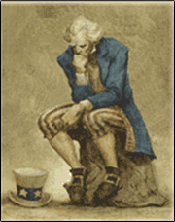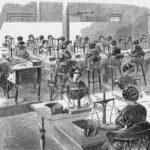
–>
June 21, 2022
“It should have been an open and closed case of a tragic robbing,” writes Gretchen Small in Bustle.com of the 2016 Seth Rich murder, “but what ensued was an alt-right conspiracy theory movement designed to take attention off of Donald Trump and put pressure on Hillary Clinton’s presidential campaign.”
‘); googletag.cmd.push(function () { googletag.display(‘div-gpt-ad-1609268089992-0’); }); }
Small accurately summarized the thesis of “A Murder in D.C.,” an episode in the Netflix series, “Web of Make Believe: Death, Lies and the Internet.” I suppose she could be forgiven her failure to know that Rich wasn’t robbed. The producers failed to share that rather critical detail, one detail out of many that allowed them to keep airheads like Small ignorant of the real scandal — the media scandal. In this case, the cover-up may well have been worse than the crime.
Although I do not know who killed Seth Rich, I do know that the media did everything in its power to discourage anyone from finding out. Ron Howard, a loyal Democrat, served as executive producer of this visually well-crafted series. Not surprisingly, the episode in question does little but showcase the media’s ongoing role as protector of Democratic secrets.
The Alt Right — whatever that is — had almost nothing to with the case save for a little internet gossip. Julian Assange, the darling of the media before he started releasing DNC emails, was the man who moved the curious beyond the “botched robbery” scenario trotted out by the D.C. Police.
‘); googletag.cmd.push(function () { googletag.display(‘div-gpt-ad-1609270365559-0’); }); }
Interviewed on Dutch TV four weeks after the shooting, Assange said, unprompted, “Whistleblowers go to significant efforts to get us material and often very significant risks. There’s a twenty-seven-year-old, works for the DNC, was shot in the back, murdered just a few weeks ago for unknown reasons as he was walking down the street in Washington.” The Netflix producers showed this interview, then spent the rest of the episode trying to dismiss its relevance.
The Dutch TV show host, as compromised as his American peers, tried to head off Assange’s line of thought. He said, “That was just a robbery, I believe. Wasn’t it?” Assange would not be reined in. Said he, accurately, “No. There’s no finding.” Although Assange evaded the question of whether Rich was a source, his offer of a $20,000 reward to find Rich’s killer raised the possibility that Rich was one.
Assange’s theorizing was given legs by B-grade media personality Ellen Ratner. The producers knew about Ratner, a Democrat and Hillary supporter. They showed her on camera and mentioned her in passing as someone who worked with Ed Butowsky, the villain of the piece. They then seem to have forgotten about her. My guess is they chose to edit Ratner’s real contribution out and overlooked the initial intro.
Butowsky, a financial guy with Republican leanings, met Ratner through their occasional TV appearances. Ratner was a friend of Assange. Her late brother Michael Ratner, a hard-core leftist, had been one of Assange’s American lawyers.
On the day after the 2016 election, Ratner boasted during an otherwise banal panel discussion at a Florida university, “I spent three hours with Julian Assange on Saturday at the Ecuadorian Embassy in London.” She then added without prompting, “One thing he did say was the leaks were not from, they were not from the Russians. They were an internal source from the Hillary campaign or from somebody that knew Hillary, an enemy.”
Fortunately for the media, Ratner’s self-involved fellow panelists ignored her comments and returned to their banalities. The video did not surface until much later. It did not interest the media when it did surface.
‘); googletag.cmd.push(function () { googletag.display(‘div-gpt-ad-1609268078422-0’); }); } if (publir_show_ads) { document.write(“
 According to a complex, multi-party defamation suit Butowsky filed in 2019, Butowsky learned of the Assange revelation from Ratner herself. She contacted him after the meeting and added the critical detail that Seth Rich was Assange’s source.
According to a complex, multi-party defamation suit Butowsky filed in 2019, Butowsky learned of the Assange revelation from Ratner herself. She contacted him after the meeting and added the critical detail that Seth Rich was Assange’s source.
Ratner reportedly told Butowsky that Assange had requested that the parents be made aware of Seth’s role, a material fact in the search for their son’s killers. Butowsky followed through with the request.
According to Butowsky, Seth’s father, Joel Rich, told him he knew that Seth and his older brother Aaron were involved with the DNC email leak. Joel chose not to go public lest people think his sons were “responsible for getting Trump elected.” Although the Riches would later deny many of Butowsky’s claims, no one disputes his offer to hire a private investigator for the Riches or their acceptance of that offer.
In order to make Butowsky and all other investigators look like right-wing conspiracy nuts, Netflix mentioned nothing about Ratner’s revelations. Nor did its producers mention the most prominent conspiracy nut of all, former DNC head Donna Brazile.
Brazile knew from experience how Assange could shape history, starting with her own employment history. On July 22, WikiLeaks began releasing the purloined DNC emails. These showed how the DNC stacked the Democratic primaries in Clinton’s favor. The Netflix show admits as much.
The revelation embarrassed then DNC chair Debbie Wasserman Schultz into resigning, and Brazile got the job. Assange’s leak of the John Podesta emails in October showed Brazile feeding CNN debate questions to Hillary Clinton and cost Brazile her job with CNN. Brazile is not interviewed, nor even mentioned in the Netflix piece. That would interfere with its twisted narrative.
In her 2017 book Hacks, Brazile talks at some length about Assange’s interview. Rich’s murder obsessed her. “All I could think about was Seth Rich,” she acknowledges. Brazile muses at one point whether Rich had been killed by “someone who had it out for Democrats” and at another whether the Russians had “played some part in his unsolved murder.” She refers to Rich on a dozen different occasions and dedicates the book to him, despite barely knowing the young programmer.
The major media had as little interest in this information as the Netflix producers. The media refused to investigate because no likely outcome had useful political value. “What seems painfully obvious to his family is that Seth Rich was, instead, the victim of a botched holdup,” the Washington Post reported lamely in a lengthy January 2017 article, six months after the murder.
The fact remained, however, that the would-be robbers took nothing: not Rich’s wallet, not his phone, not his watch, not an expensive pendant that he wore. In the three months between June 1 and September 1, 2016, he was the only person murdered within five hundred yards of his home. That he was murdered “about 300 steps from his front door” at about 4 a.m. suggests someone was waiting for him.
Six months after the shooting, the Metropolitan Police were refusing to answer questions on the case, to show a grainy video of his two assailants, to share Rich’s comments in the hour or so he lived after the shooting, or to explain why it took nearly three hours for him to walk the thirty or so minutes from a local bar to his home.
The D.C. police attributed their silence to fear of compromising “an ongoing investigation.” Six years later, the investigation is dead, but the silence continues. The only people who made any effort at all to break the case served as the bad guys in this disgraceful Netflix saga.
In a wildly contorted effort, the producers showed their own ability to spread conspiracy theories by gratuitously pulling even President Trump into the mix. Opie, you should never have left Mayberry.
For more information, see “Seth Rich: The Murder Washington Doesn’t Want Solved.”
Image: Pixabay
<!– if(page_width_onload <= 479) { document.write("
“); googletag.cmd.push(function() { googletag.display(‘div-gpt-ad-1345489840937-4’); }); } –> If you experience technical problems, please write to [email protected]
FOLLOW US ON
<!–
–>
<!– _qoptions={ qacct:”p-9bKF-NgTuSFM6″ }; ![]() –> <!—-> <!– var addthis_share = { email_template: “new_template” } –>
–> <!—-> <!– var addthis_share = { email_template: “new_template” } –>





